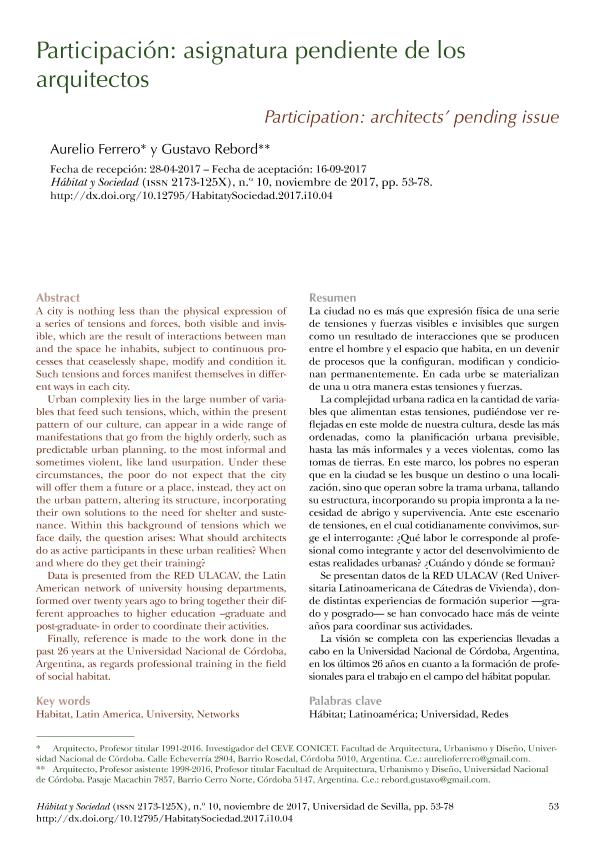Mostrar el registro sencillo del ítem
dc.contributor.author
Ferrero, Aurelio Antonio

dc.contributor.author
Rebord, Gustavo

dc.date.available
2018-04-25T14:34:05Z
dc.date.issued
2017-11
dc.identifier.citation
Ferrero, Aurelio Antonio; Rebord, Gustavo; Participación: asignatura pendiente de los arquitectos; Universidad de Sevilla; Hábitat y Sociedad; 10; 11-2017; 53-78
dc.identifier.issn
2173-125X
dc.identifier.uri
http://hdl.handle.net/11336/43441
dc.description.abstract
La ciudad no es más que expresión física de una serie de tensiones y fuerzas visibles e invisibles que surgen como un resultado de interacciones que se producen entre el hombre y el espacio que habita, en un devenir de procesos que la configuran, modifican y condicionan permanentemente. En cada urbe se materializan de una u otra manera estas tensiones y fuerzas. La complejidad urbana radica en la cantidad de variables que alimentan estas tensiones, pudiéndose ver reflejadas en este molde de nuestra cultura, desde las más ordenadas, como la planificación urbana previsible, hasta las más informales y a veces violentas, como las tomas de tierras. En este marco, los pobres no esperan que en la ciudad se les busque un destino o una localización, sino que operan sobre la trama urbana, tallando su estructura, incorporando su propia impronta a la necesidad de abrigo y supervivencia. Ante este escenario de tensiones, en el cual cotidianamente convivimos, surge el interrogante: ¿Qué labor le corresponde al profesional como integrante y actor del desenvolvimiento de estas realidades urbanas? ¿Cuándo y dónde se forman? Se presentan datos de la RED ULACAV (Red Universitaria Latinoamericana de Cátedras de Vivienda), donde distintas experiencias de formación superior -grado y posgrado- se han convocado hace más de veinte años para coordinar sus actividades. La visión se completa con las experiencias llevadas a cabo en la Universidad Nacional de Córdoba, Argentina, en los últimos 26 años en cuanto a la formación de profesionales para el trabajo en el campo del hábitat popular.
dc.description.abstract
A city is nothing less than the physical expression of a series of tensions and forces, both visible and invisible, which are the result of interactions between man and the space he inhabits, subject to continuous processes that ceaselessly shape, modify and condition it. Such tensions and forces manifest themselves in different ways in each city. Urban complexity lies in the large number of variables that feed such tensions, which, within the present pattern of our culture, can appear in a wide range of manifestations that go from the highly orderly, such as predictable urban planning, to the most informal and sometimes violent, like land usurpation. Under these circumstances, the poor do not expect that the city will offer them a future or a place, instead, they act on the urban pattern, altering its structure, incorporating their own solutions to the need for shelter and sustenance. Within this background of tensions which we face daily, the question arises: What should architects do as active participants in these urban realities? When and where do they get their training? Data is presented from the RED ULACAV, the Latin American network of university housing departments, formed over twenty years ago to bring together their different approaches to higher education –graduate and post-graduate- in order to coordinate their activities. Finally, reference is made to the work done in the past 26 years at the Universidad Nacional de Córdoba, Argentina, as regards professional training in the field of social habitat.
dc.format
application/pdf
dc.language.iso
spa
dc.publisher
Universidad de Sevilla

dc.rights
info:eu-repo/semantics/openAccess
dc.rights.uri
https://creativecommons.org/licenses/by-nc-sa/2.5/ar/
dc.subject
Habitat
dc.subject
Latinoamerica
dc.subject
Universidad
dc.subject
Redes
dc.subject.classification
Estudios Urbanos

dc.subject.classification
Geografía Económica y Social

dc.subject.classification
CIENCIAS SOCIALES

dc.title
Participación: asignatura pendiente de los arquitectos
dc.title
Participation: architects’ pending issue
dc.type
info:eu-repo/semantics/article
dc.type
info:ar-repo/semantics/artículo
dc.type
info:eu-repo/semantics/publishedVersion
dc.date.updated
2018-04-24T19:33:02Z
dc.journal.number
10
dc.journal.pagination
53-78
dc.journal.pais
España

dc.description.fil
Fil: Ferrero, Aurelio Antonio. Universidad Nacional de Córdoba. Facultad de Arquitectura, Urbanismo y Diseño; Argentina. Consejo Nacional de Investigaciones Científicas y Técnicas; Argentina
dc.description.fil
Fil: Rebord, Gustavo. Universidad Nacional de Córdoba. Facultad de Arquitectura, Urbanismo y Diseño; Argentina
dc.journal.title
Hábitat y Sociedad
dc.relation.alternativeid
info:eu-repo/semantics/altIdentifier/doi/http://dx.doi.org/10.12795/HabitatySociedad.2017.i10.04
dc.relation.alternativeid
info:eu-repo/semantics/altIdentifier/url/https://revistascientificas.us.es/index.php/HyS/article/view/4505
Archivos asociados
